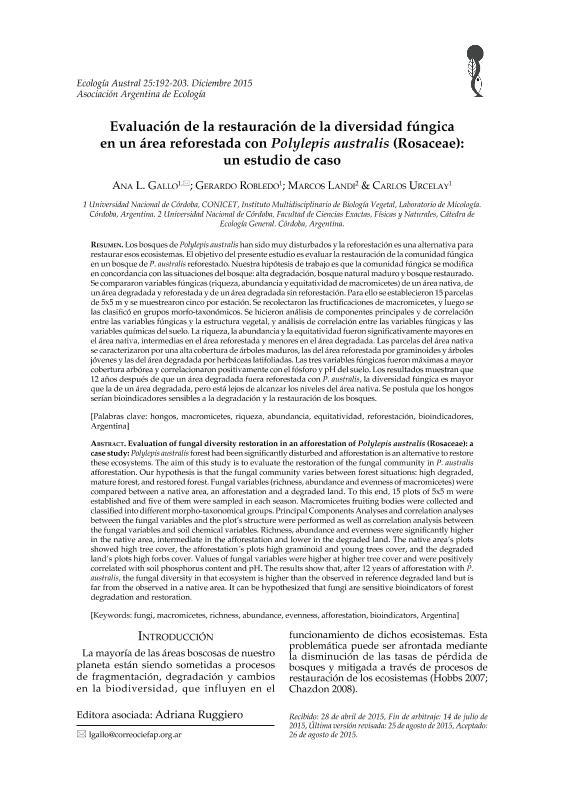Artículo
Los bosques de Polylepis australis han sido muy disturbados y la reforestación es una alternativa para restaurar esos ecosistemas. El objetivo del presente estudio es evaluar la restauración de la comunidad fúngica en un bosque de P. australis reforestado. Nuestra hipótesis de trabajo es que la comunidad fúngica se modifica en concordancia con las situaciones del bosque: alta degradación, bosque natural maduro y bosque restaurado.Se compararon variables fúngicas (riqueza, abundancia y equitatividad de macromicetes) de un área nativa, deun área degradada y reforestada y de un área degradada sin reforestación. Para ello se establecieron 15 parcelas de 5x5 m y se muestrearon cinco por estación. Se recolectaron las fructificaciones de macromicetes, y luego se las clasificó en grupos morfo-taxonómicos. Se hicieron análisis de componentes principales y de correlación entre las variables fúngicas y la estructura vegetal, y análisis de correlación entre las variables fúngicas y las variables químicas del suelo. La riqueza, la abundancia y la equitatividad fueron significativamente mayores en el área nativa, intermedias en el área reforestada y menores en el área degradada. Las parcelas del área nativa se caracterizaron por una alta cobertura de árboles maduros, las del área reforestada por graminoides y árboles jóvenes y las del área degradada por herbáceas latifoliadas. Las tres variables fúngicas fueron máximas a mayor cobertura arbórea y correlacionaron positivamente con el fósforo y pH del suelo. Los resultados muestran que 12 años después de que un área degradada fuera reforestada con P. australis, la diversidad fúngica es mayor que la de un área degradada, pero está lejos de alcanzar los niveles del área nativa. Se postula que los hongos serían bioindicadores sensibles a la degradación y la restauración de los bosques. Polylepis australis forest had been significantly disturbed and afforestation is an alternative to restore these ecosystems. The aim of this study is to evaluate the restoration of the fungal community in P. australis afforestation. Our hypothesis is that the fungal community varies between forest situations: high degraded, mature forest, and restored forest. Fungal variables (richness, abundance and evenness of macromicetes) were compared between a native area, an afforestation and a degraded land. To this end, 15 plots of 5x5 m were established and five of them were sampled in each season. Macromicetes fruiting bodies were collected and classified into different morpho-taxonomical groups. Principal Components Analyses and correlation analyses between the fungal variables and the plot's structure were performed as well as correlation analysis between the fungal variables and soil chemical variables. Richness, abundance and evenness were significantly higher in the native area, intermediate in the afforestation and lower in the degraded land. The native area's plots showed high tree cover, the afforestation´s plots high graminoid and young trees cover, and the degraded land's plots high forbs cover. Values of fungal variables were higher at higher tree cover and were positively correlated with soil phosphorus content and pH. The results show that, after 12 years of afforestation with P. australis, the fungal diversity in that ecosystem is higher than the observed in reference degraded land but is far from the observed in a native area. It can be hypothesized that fungi are sensitive bioindicators of forest degradation and restoration
Evaluación de la restauración de la diversidad fúngica en un área reforestada con Polylepis australis (Rosaceae): un estudio de caso
Título:
Evaluation of fungal diversity restoration in an afforestation of Polylepis australis (Rosaceae): a case study
Fecha de publicación:
12/2015
Editorial:
Asociación Argentina de Ecología
Revista:
Ecología Austral
ISSN:
0327-5477
e-ISSN:
1667-782X
Idioma:
Español
Tipo de recurso:
Artículo publicado
Clasificación temática:
Resumen
Palabras clave:
Hongos
,
Macromicetes
,
Riqueza
,
Abundancia
Archivos asociados
Licencia
Identificadores
Colecciones
Articulos(IMBIV)
Articulos de INST.MULTIDISCIPL.DE BIOLOGIA VEGETAL (P)
Articulos de INST.MULTIDISCIPL.DE BIOLOGIA VEGETAL (P)
Articulos(SEDE CENTRAL)
Articulos de SEDE CENTRAL
Articulos de SEDE CENTRAL
Citación
Gallo, Ana Laura; Robledo, Gerardo Lucio; Landi, Marcos Alejandro; Urcelay, Roberto Carlos; Evaluación de la restauración de la diversidad fúngica en un área reforestada con Polylepis australis (Rosaceae): un estudio de caso; Asociación Argentina de Ecología; Ecología Austral; 25; 3; 12-2015; 192-203
Compartir




